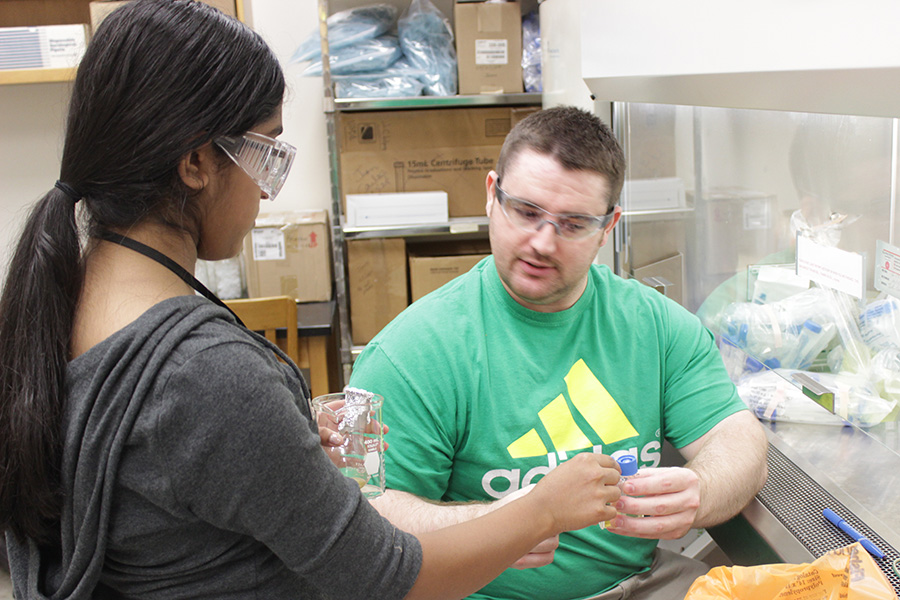The halls of Illinois State University are not as quiet as you might think in the summer.
On Tuesday afternoon, in the bowels of Old Union, about a dozen high school students were tearing down and custom rebuilding Dell computers under the gaze of Illinois State faculty and students. Down the hall, another group of students were programming Lego Mindstorm robots to complete simple tasks, like knocking down cans of a specific color.
“It’s a struggle,” said Keenan Wilcott, an incoming senior at Decatur’s Lutheran School Association. But he added that working with the robots was “phenomenal.”
The students were among 47 high school students who have been getting a taste of the college life this week at Illinois State through the annual Illinois Summer Research Academy. The University’s Center for Mathematics, Science, and Technology (CeMaST) funds and organizes the weeklong program.
“We started it six years ago with the aim of trying to provide high school sophomores, juniors, and seniors a really positive research experience on campus,” said CeMaST Director William Hunter. “They get to know some faculty members, and get to know something about their potential own future, and understand that ISU is an interesting place where there is lots of good, quality research in which they could potentially be involved.”

High school student Liliana Wang (center) speaks with Chemistry Professor Marjorie Jones during the Illinois Research Academy. Nine students, including Mrunal Shah (left), have been conducting research in Jones’ lab during the weeklong program.
Almost 250 students from across Illinois have attended the academy over the years and been able to do hands-on research with professors in chemistry, the other natural sciences, the social sciences, and information technology.
“We help them to try something that is a little bit investigative and that is really closely related to a faculty member’s research,” Hunter said.
For example, nine students have been working in Chemistry Professor Marjorie Jones’ lab in the Science Laboratory Building. Jones had them test an extract from a Brazilian tree’s bark to see if any of the compounds could be used to develop a cure for the flesh-eating disease leishmaniasis.
Jones said there are not many good drugs to treat the potentially fatal disease that is spread by infected sandflies and affects 20–25 million people worldwide. She predicted the disease could arrive in the U.S. within the next 10 years.
Jones said it’s very important to get students and the public to understand that research is crucial.
Without it, “then how do you solve these problems?” she said.

High school student Ezra Perrien is tearing down and rebuilding a Dell computer, circa 2009, during the research academy.
The students also work with university research assistants, like Benjamin Dorsey ’15, who graduated in May with a chemistry degree. Dorsey was helping the students with some of the complicated techniques and showing them how the scientific methodology works.
“What I try to do the first day was to explain to them, We are doing this technique and this is why we are doing it,” Dorsey said. “The methodology is important. They may not be biochemists, but if they want to be scientists, this will be a useful experience.”
On Tuesday, Dorsey showed high school sophomore Sannidhi Sarvadhavabhatla and other students how to label flasks being used for Jones’ experiments. Sarvadhavabhatla said she had been learning how careful a scientist has to be when working with cells.
“Everything is exact,” said Sarvadhavabhatla, a sophomore at Stevenson High School in Lincolnshire.
The students said they were enjoying the research experience, meeting new people, and the freedom of being away from home for a week. Netwin Trieu, an incoming senior at Mather High School in Chicago, said he was attending the academy because he liked computing and information technology.

Kevin Criollo (left), Dino Numanovic, and Jeremy Chionglo experiment with Arduino microprocessors during the research academy.
“It’s a lot to take in,” he said.
Trieu’s favorite part had been experimenting with the Raspberry Pis, which were given to each student in the IT section of the academy. These uncovered, palm-size computers have the capabilities and power to match their much larger desktop cousins, said Professor Glen Sagers, assistant director of the School of Information Technology.
“It’s small, it’s unique,” Sagers said.
Sagers said the IT academy is designed to give the high school students an appreciation of the variety of careers they can choose from and the ability to do some programming and understand the logic behind it.
“They’re here because they want to learn,” he said.
Kevin Bersett can be reached at kdberse@IllinoisState.edu.
To read more about research, creative expression, and scholarship at Illinois State University, follow @ISUResearch on Twitter and look for the inaugural issue of the Redbird Scholar. The University’s new biannual magazine focused on faculty and student research will be published in print and online for the first time in September.


This activity is very meaningful, especially for those students, it will enhance student’s study enthusiasm.